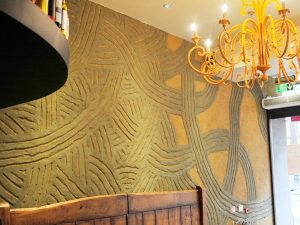Including cleaning, protecting, painting and repairing.
Can clay plaster be cleaned?
If glazed, the plaster can be cleaned by wiping with a damp cloth.
Can I hang pictures?
Depends on what’s under the plaster – but it’s exactly the same as for conventional plasters.
Should I protect / paint the plaster?
You can use a translucent wall glaze to achieve a protective, nontoxic, breathable finish. This glaze makes the plaster more durable to knocks and bumps, and allows it to be wiped gently with a damp sponge. It also provides a deep, lustrous sheen, bringing out the rich nature of the plaster. Apply a minimum of two coats and up to four for areas of high traffic.
To apply the glaze, wait until the plaster is fully dry. Allow several days, depending on prevailing temperature/humidity and rate of wall suction. Mix the glaze with clean water in a ratio of 2 parts glaze to 1 part clean water. Apply with a clean, soft paintbrush, taking care not to saturate the wall. Cover roughly 0.5m² at a time. Work the glaze into the plaster with a plastic trowel using forceful strokes in all directions, until all traces of white glaze have been distributed over the wall surface. Move excess glaze onto a dry section of wall using a brush or plastic trowel. Continue this process until the wall has been covered. Wait 24 hours before applying a second coat. The second coat, as well as all subsequent coats, should be applied in a ratio of 1 part glaze to 1 part clean water. Glazes can be reapplied whenever the wall needs freshening (1:1 ratio).
Clay plaster can be finished without applying the protective glaze. This will produce a lighter, matte finish. It can also painted with limewash or natural, micro-porous ie breathable paint, such as clay paint. This can be applied straight onto the dry plaster, or on top of the glaze if painting is desired at a later date.
Can I repair clay plaster?
Clay plasters do not chemically set, which means that they can be repaired at any time.
- Chamfer the edges of the damaged area and locally moisten with a spray mister or wet paintbrush.
- Push wet plaster into the damaged area using a steel trowel.
- Press back with a plastic trowel, working the edges to minimise creating a lip.
- Polish the new plaster with the plastic trowel and allow to dry.
- Glaze (as described above).
There may be a slight discolouration of the repaired area, but if carefully done, any trace can be negligible. For small, hairline cracks, spray the wall with water, then press back the cracks with a plastic trowel.
Thanks to Clayworks for information.

